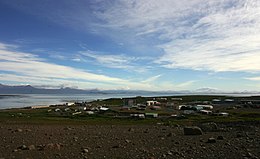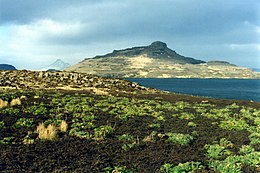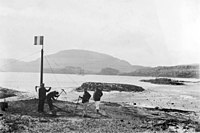|
Kerguelen Islands
The Kerguelen Islands (/kərˈɡeɪlən/ or /ˈkɜːrɡələn/;[2] in French commonly Îles Kerguelen but officially Archipel Kerguelen,[3] pronounced [kɛʁɡelɛn]), also known as the Desolation Islands (Îles de la Désolation in French), are a group of islands in the sub-Antarctic region. They are among the most isolated places on Earth, with the closest territory being the Heard Island and McDonald Islands territory of Australia located at roughly 450 km (240 nmi), and the nearest inhabited territory being Madagascar at more than 3,300 kilometres (1,800 nautical miles) in distance. The islands, along with Adélie Land, the Crozet Islands, Amsterdam and Saint Paul islands, and France's Scattered Islands in the Indian Ocean, are part of the French Southern and Antarctic Lands and are administered as a separate district. The islands constitute one of the two exposed parts of the Kerguelen Plateau (the other being Heard Island and the McDonald islands), a large igneous province mostly submerged in the southern Indian Ocean. The main island, Grande Terre, is 6,675 km2 (2,577 sq mi) in area, about three-quarters of the size of Corsica, and is surrounded by a further 300 smaller islands and islets,[4] forming an archipelago of 7,215 km2 (2,786 sq mi). The climate is harsh and chilly with frequent high winds throughout the year. The surrounding seas are generally rough and they remain ice-free year-round. There are no indigenous inhabitants, but France maintains a permanent presence of 45 to 100 soldiers, scientists, engineers, and researchers.[5] There are no airports on the islands, so all travel to and from the outside world is by ship. HistoryBefore being officially catalogued in 1772, the Kerguelen Islands appear as the "Ile de Nachtegal" on Philippe Buache's 1754 map entitled Carte des Terres Australes comprises entre le Tropique du Capricorne et le Pôle Antarctique où se voyent les nouvelles découvertes faites en 1739 au Sud du Cap de Bonne Esperance ('Map of the Southern Lands contained between the Tropic of Capricorn and the Antarctic Pole, where the new discoveries made in 1739 to the south of the Cape of Good Hope may be seen'). It is possible this early name was after Abel Tasman's ship De Zeeuwsche Nachtegaal. On the Buache map, "Ile de Nachtegal" is located at 43°S, 72°E, about 6° north and 2° east of the accepted location of Grande Terre. The islands were officially discovered by the French navigator Yves-Joseph de Kerguelen-Trémarec on 12 February 1772. The next day, Charles de Boisguehenneuc landed and claimed the island for the French crown.[6] Yves de Kerguelen organised a second expedition in 1773 and arrived at the "baie de l'Oiseau" by December 1773. On 6 January 1774 he commanded his lieutenant, Henri Pascal de Rochegude, to leave a message notifying any passers-by of the two passages and of the French claim to the islands.[7] Thereafter, a number of expeditions briefly visited the islands, including the third voyage of Captain James Cook in December 1776. Cook verified and confirmed the passage of de Kerguelen by discovering and annotating the message left by the French navigator.[7] Soon after its discovery, the archipelago was regularly visited by whalers and sealers (mostly British, American, and Norwegian) who hunted the resident populations of whales and seals to the point of near extinction, including fur seals in the 18th century and elephant seals in the 19th century. The sealing era lasted from 1781 to 1922 during which time 284 sealing visits are recorded, nine of which ended when the vessel was wrecked.[8]: 167 Modern industrial sealing, associated with whaling stations, occurred intermittently between 1908 and 1956. Since the end of the whaling and sealing era, most of the islands' species have been able to increase their population again.[9] Relics of the sealing period include try pots, hut ruins, graves and inscriptions.[8]: 167 In 1800, the Hillsborough spent eight months sealing and whaling around the islands. During this time Captain Robert Rhodes, her master, prepared a chart of the islands.[10] That vessel returned to London in April 1801 with 450 tons of sea elephant oil.[11] In 1825, the British sealer John Nunn and three crew members from Favourite were shipwrecked on Kerguelen until they were rescued in 1827 by Captain Alexander Distant during his hunting campaign.[12][13] The islands were not completely surveyed until the Ross expedition of 1840.[14] The Australian James Kerguelen Robinson (1859–1914) was the first human born south of the Antarctic Convergence, on board the sealing ship Offley in Gulf of Morbihan (Royal Sound then), Kerguelen Island on 11 March 1859.[15][16] In 1874–1875, British, German, and U.S. expeditions visited Kerguelen to observe the transit of Venus.[17] For the 1874 transit, George Biddell Airy of the U.K. Royal Observatory organised and equipped five expeditions to different parts of the world. Three of these were sent to the Kerguelen Islands and led by Stephen Joseph Perry, who set up his main observation station at Observatory Bay and two auxiliary stations, one at Thumb Peak led by Sommerville Goodridge, and the second at Supply Bay, led by Cyril Corbet. Observatory Bay was also used by the German Antarctic Expedition, led by Erich Dagobert von Drygalski in 1902–1903. In January 2007, an archaeological excavation was carried out at this site. In 1877 the French started a coal mining operation, but soon abandoned it.[18] In 1892, due to German operations in the area, France sent the aviso Eure, under Commander Lieutard, to reassert its claim over the Kerguelen Islands, the islands of Amsterdam and St. Paul, and the Crozet Archipelago. In 1924, it was decided to administer these territories (in addition to that portion of Antarctica claimed by France and known as Adélie Land) from Madagascar; as with all Antarctic territorial claims, France's possession on the continent is held in abeyance until a new international treaty is ratified that defines each claimant's rights and obligations. In 1908, the French explorer Raymond Rallier du Baty made a privately funded expedition to the island. His autobiographical account of the adventure (15,000 Miles in a Ketch. Thomas Nelson and Sons: London, 1917) describes the months that he spent surveying the island and hunting seals to finance his expedition. The German auxiliary cruiser Atlantis called at Kerguelen during December 1940. During their stay the crew performed maintenance and replenished their water supplies. This ship's first fatality of the war occurred when a sailor, Bernhard Herrmann, fell while painting the funnel. He is buried in what is sometimes referred to as "the southernmost German war grave" of World War II. Kerguelen has been continually occupied since 1950 by scientific research teams, with a population of 50 to 100 personnel frequently present.[5] There is also a French satellite tracking station. Until 1955, the Kerguelen Islands were administratively part of the French Colony of Madagascar and Dependencies. That same year, they collectively became known as Les Terres australes et antarctiques françaises (French Southern and Antarctic Lands) and were administratively part of the French Département d'outre-mer de la Réunion. In 2004 they were permanently transformed into their own entity (keeping the same name) but having inherited another group of five very remote tropical islands, les îles Éparses, which are also ruled by France and are dispersed widely throughout the southern Indian Ocean.[clarification needed]
Grande Terre    The main island of the archipelago is called La Grande Terre. It measures 150 km (93 mi) east to west and 120 km (75 mi) north to south. Port-aux-Français, a scientific base, is along the eastern shore of the Gulf of Morbihan on La Grande Terre. Facilities there include scientific-research buildings, a satellite tracking station, dormitories, a hospital, a library, a gymnasium, a pub, and the chapel of Notre-Dame des Vents. The highest point is Mont Ross in the Gallieni Massif, which rises along the southern coast of the island and has an elevation of 1,850 metres (6,070 ft). The Cook Ice Cap (French: Calotte Glaciaire Cook),[19] France's largest glacier with an area of about 403 km2 (156 sq mi), lies on the west-central part of the island. Overall, the glaciers of the Kerguelen Islands cover just over 500 km2 (190 sq mi). Grande Terre has also numerous bays, inlets, fjords, and coves, as well as several peninsulas and promontories. The most important ones are listed below:
Notable localitiesThere are also a number of notable localities, all on La Grande Terre (see also the main map):
From 1968 to 1981, a site just east of Port-aux-Français was a launching site for sounding rockets, some for French (Dragon rockets), American (Arcas) or French-Soviet (Eridans) surveys, but at the end mainly for a Soviet program (M-100).[21] IslandsThe following is a list of the most important adjacent islands:
Economy
 Principal activities on the Kerguelen Islands focus on scientific research, mostly earth sciences and biology. The former sounding rocket range to the east of Port-aux-Français is currently the site of a SuperDARN radar. Since 1992, the French Centre National d'Études Spatiales (CNES) has operated a satellite and rocket tracking station, located four kilometres (2+1⁄2 mi) east of Port-aux-Français. CNES needed a tracking station in the Southern Hemisphere, and the French government required that it be located on French territory, rather than in a populated, but foreign, place like Australia or New Zealand. Agricultural activities were limited until 2007 to raising sheep (about 3,500 Bizet sheep, a breed that is rare in mainland France) on Longue Island for consumption by the occupants of the base, as well as small quantities of vegetables in a greenhouse within the immediate vicinity of the main French base. There are also feral rabbits and sheep that can be hunted, as well as wild birds. There are also five fishing boats and vessels, owned by fishermen on Réunion Island (a department of France about 3,500 km or 1,900 nmi north) who are licensed to fish within the archipelago's exclusive economic zone. Geology  The Kerguelen Islands form an emerged part of the submerged Kerguelen Plateau, which has a total area nearing 949,000 km2 (366,000 sq mi).[22] The plateau was built by volcanic eruptions associated with the Kerguelen hotspot, and now lies on the Antarctic Plate.[23] The major part of the volcanic formations visible on the islands is characteristic of an effusive volcanism, which caused a trap rock formation to start emerging above the level of the ocean 35 million years ago. The accumulation is of a considerable amount; basalt flows, each with a thickness of three to ten metres, stacked on top of each other, sometimes up to a depth of 1,200 metres (660 fathoms). This form of volcanism creates a monumental relief shaped as stairs of pyramids. Other forms of volcanism are present locally, such as the strombolian volcano Mont Ross, and the volcano-plutonic complex on the Rallier du Baty Peninsula. Various veins and extrusions of lava such as trachytes, trachyphonolites, and phonolites are common all over the islands. No eruptive activity has been recorded in historic times, but some fumaroles are still active in the south-west of Grande-Terre island. Fossilized wood found in the islands has been identified as Araucarians and Cypresses, showing that the islands were once forested with conifers.[24] While an exact date for these wood fragments is unknown, they have been tentatively described as being from the early Cenozoic. The presence of these species may suggest that Kerguelen's prehistoric flora may have been similar to the Antarctic flora found across the southern hemisphere. Glaciation caused the depression and tipping phenomena which created the gulfs at the north and east of the archipelago. Erosion caused by the glacial and fluvial activity carved out the valleys and fjords; erosion also created conglomerate detrital complexes, and the plain of the Courbet Peninsula. The islands are part of a submerged microcontinent called the Kerguelen Subcontinent.[25] The microcontinent emerged substantially above sea level for three periods between 100 million years ago and 20 million years ago. The so-called Kerguelen Subcontinent may have had tropical flora and fauna about 50 million years ago. The Kerguelen Subcontinent finally sank 20 million years ago and is now one to two kilometres (550 to 1,100 fathoms) below sea level. Kerguelen's sedimentary rocks are similar to ones found in Australia and India, indicating they were all once connected. Scientists hope that studying the Kerguelen sub-continent will help them discover how Australia, India, and Antarctica broke apart.[26] ClimateKerguelen's climate is oceanic, cold, and extremely windswept. Under the Köppen climate classification, Kerguelen's climate is considered to be an ET or tundra climate, which is technically a form of polar climate, as the average temperature in the warmest month is below 10 °C (50 °F).[27] Comparable climates include the Aleutian Islands, Campbell Island (New Zealand), Falkland Islands, Iceland, northern Kamchatka Peninsula (Russia), Labrador (Canada), and Wollaston Islands (Chile). All climate readings come from the Port-aux-Français base, which has one of the more favourable climates in Kerguelen because of its proximity to the coast and its location in a gulf sheltered from the wind. The average annual temperature is 4.9 °C (40.8 °F) with an annual range of around 6 °C (11 °F). The warmest months of the year include January and February, with average temperatures between 7.8 and 8.2 °C (46.0 and 46.8 °F). The coldest month of the year is August with an average temperature of 2.1 °C (35.8 °F). Annual high temperatures rarely surpass 20 °C (68 °F), while temperatures in winter have never been recorded below −10 °C (14 °F) at sea level. Kerguelen receives frequent precipitation, with snow throughout the year as well as rain. Port-aux-Français receives a modest amount of precipitation (708 mm or 27+7⁄8 in per annum) compared to the west coast which receives an estimated three times as much precipitation per year. The mountains are frequently covered in snow but can thaw very quickly in rain. Over the course of several decades, many permanent glaciers have shown signs of retreat, with some smaller ones having disappeared completely. The west coast receives almost continuous wind at an average speed of 35 km/h (19 kn; 10 m/s) because the islands are between the Roaring Forties and the Furious Fifties. Wind speeds of 150 km/h (81 kn; 42 m/s) are common and can even reach 200 km/h (110 kn; 56 m/s). Waves up to 12–15 m (39–49 ft) high are common, but there are many sheltered places where ships can anchor.
Flora and fauna The islands are part of the Southern Indian Ocean Islands tundra ecoregion that includes several subantarctic islands. Plant life is mainly limited to grasses, mosses, and lichens, although the islands are also known for the indigenous, edible Kerguelen cabbage, a good source of vitamin C to mariners.[30] The main indigenous animals are insects along with large populations of ocean-going seabirds, seals, and penguins.[31] The wildlife is particularly vulnerable to introduced species; one particular problem has been cats. The main island is the home of a well-established feral cat population, descended from ships' cats.[32] They survive on sea birds and the feral rabbits that were introduced to the islands. There are also populations of wild sheep (Ovis orientalis orientalis) and reindeer. In the 1950s and 1960s, French geologist Edgar Albert de la Rue began to introduce several species of salmonids. Of the seven species introduced, only brook trout Salvelinus fontinalis and brown trout Salmo trutta survived to establish wild populations.[33] Coleoptera
In popular cultureThe islands appear in a number of fictional works:
See also
References
External linksWikimedia Commons has media related to Kerguelen Islands. Wikivoyage has a travel guide for Kerguelen. The Wikibook Geography of France has a page on the topic of: Kerguelen Islands
|
||||||||||||||||||||||||||||||||||||||||||||||||||||||||||||||||||||||||||||||||||||||||||||||||||||||||||||||||||||||||||||||||||||||||||||||||||||||||||||||||||||||||||||||||||||||||||||||||||||||||||||||||||||||||||||||||||||||||||||||||||||||||||||||




![Christmas Harbour, Kerguelens Land, 1811, by the English engraver George Cooke;[7] the location is now known as Port-Christmas](http://upload.wikimedia.org/wikipedia/commons/thumb/2/2f/Christmas_Harbour_Kerguelens_Land%2C_1811.jpg/200px-Christmas_Harbour_Kerguelens_Land%2C_1811.jpg)



